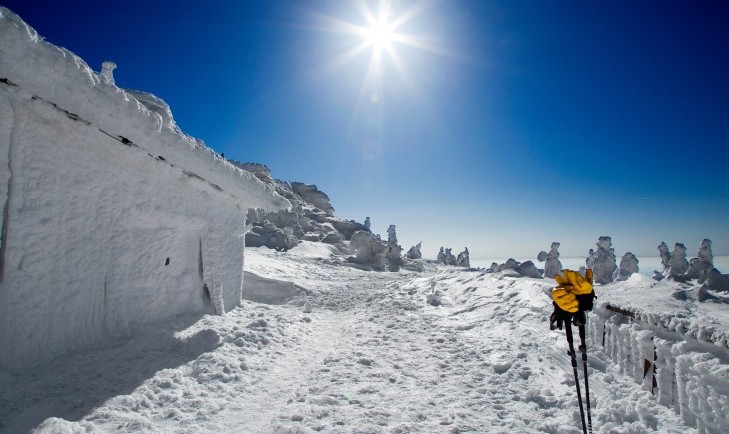
The Western Governors' Association keeps you updated on the latest news in the West. Here are the top stories for the week starting March 18, 2024. (Photos courtesy of Natural Resources Conservation Service, the CSU Department of Mechanical Engineering researchers, and the Artic Winter Games).
Thanks to a snowy February and some heavy early spring storms, much of the west’s snowpack has surpassed the historical averages.
After lagging earlier this winter, Colorado’s mountain snowpack recently measured 109% of the 30-year norm, setting up the potential for another summer with healthy water supplies.
“We’re sitting pretty right now,” National Weather Service meteorologist Caitlyn Mensch said. “We’re above 100% everywhere, which is positive to see as we head into spring.”
The latest storm also boosted Oregon’s snowpack to 109% of normal and continued to decrease drought levels to the lowest they’ve been since 2019.
.png) In particular, Mt. Hood, Oregon picked up about 6-8 feet of new snow between February 26 and March 4. In that window, many areas saw massive increases in snowpack levels, going from 70-89% of their normal snowpack to over 100%.
In particular, Mt. Hood, Oregon picked up about 6-8 feet of new snow between February 26 and March 4. In that window, many areas saw massive increases in snowpack levels, going from 70-89% of their normal snowpack to over 100%.
Utah’s snowpack is also looking quite good with the statewide snowpack currently at 124% of the 30-year median, according to the Utah Snow Survey, which is celebrating its 100th anniversary tracking snowpack in the state.
The California snowpack is in a similarly positive position, having surpassed the historical average for this time of year. Meteorologists expect that a storm forecast for this weekend could deepen it even more, with the peak coming in mid-April before melting intensifies.
While snowpack in Idaho’s northern areas remains below 30-year medians partly because of the dominant El Nino weather pattern that pushes Pacific storms south, a wet February and early March have boosted snowpacks in much of southern Idaho to near-normal and above-normal levels.
“Despite the varying snowpack levels in the state this winter, a lot of the reservoir storage looks good across the state,” said Andrew Paxton of the NRCS Idaho Snow Survey staff.
Water volume in the Upper Snake reservoir system is about 120% of the long-term median, said Jeremy Dalling, water operations civil engineer with the U.S. Bureau of Reclamation Upper Snake Field Office. Natural flows are good.
Even Montana, which has experienced an extremely dry winter, got some relief from the early spring storms. The Gallatin basin recorded precipitation levels 113% of normal, the Madison basin saw levels 147% of normal, and the Upper Yellowstone saw levels 120% of normal for the month.
Cost-Effective Carbon Capture: Spiritus, a San Fransico-based start-up, recently announced plans to build its first direct air capture (DAC) project, one that the company says will be able to capture carbon for less than $100 per ton. Most carbon capture companies in the field are reluctant to reveal their current costs, but the industry average price is believed to be between $600 and $1,000 per ton. Located in central Wyoming, the Spiritus DAC project known as Orchard One will eventually capture 2 million tons of CO2 per year.
Geothermal Expansion: Geothermal energy produced from the heat beneath the Earth’s surface could increase twentyfold in the U.S. by 2050, according to a new U.S. Department of Energy report.
“The U.S. can lead the clean energy future with continued innovation on next-generation technologies, from harnessing the power of the sun to the heat beneath our feet, and cracking the code to deploy them at scale,” said Energy Secretary Jennifer Granholm in a statement. The report, she said, “showcases the enormous potential for geothermal energy and that with strong public-private partnerships we can lower costs for this hot technology to expand access for cleaner, more reliable power to communities across the nation.”
In the same vein, Senators Mike Lee (UT), Martin Heinrich (NM), James Risch (ID), and Catherine Cortez Masto (NV), all members of the Senate Energy and Natural Resources Committee, introduced the Geothermal Energy Optimization (GEO) Act to accelerate the adoption of geothermal energy nationwide.
Computer Chips: The Biden administration has reached an agreement to provide Intel with up to $8.5 billion in direct funding and $11 billion in loans for computer chip plants in four states, a cash infusion that the government says should help the U.S. boost its global share of advanced chip production from zero to 20%.
The announcement comes just one week after the Western Governors' Association expressed their support for measures in the bipartisan and bicameral Building Chips in America Act that would streamline the environmental review process for projects receiving funding under the CHIPS and Science Act of 2022, and urged Congressional leadership to work on comprehensive permitting reforms that increase transparency, accessibility, and agency accountability for all projects. Read their full correspondence for additional details.
.jpeg) Olympics of the North: The biennial Arctic Winter Games, a multi-sport and cultural event hosted by contingents in the Arctic region, specifically focusing on circumpolar communities from areas like Canada, Alaska, Kalaallit Nunaat, and Northern Scandinavia, were recently hosted in Mat-Su, Alaska.
Olympics of the North: The biennial Arctic Winter Games, a multi-sport and cultural event hosted by contingents in the Arctic region, specifically focusing on circumpolar communities from areas like Canada, Alaska, Kalaallit Nunaat, and Northern Scandinavia, were recently hosted in Mat-Su, Alaska.
With its home-team advantage, Alaska took home the most ulus — 221 in total, including 70 gold. Team Yukon came in second in the overall medal count and was also the winner of the coveted Hogsdon award — a seven-foot-high trophy, hand-carved from a narwhal tusk, with a bear that clings to the top. It honors the team that best exemplifies the values of the Arctic Winter Games: team spirit, cooperation, and fair play.